Three brothers and an auto buggy: Building 1907 vehicle from scratch a family project
Equipped with an antique frame, wheels and the inspiration to start a new project, the Grimm brothers of Rapid City have custom built a hydraulic-powered 1907 International Harvester high-wheeler auto buggy.
The auto buggy was a brief trend in early automotive history. According to classic.com, the International Harvester Auto Buggy was the first automobile produced by the company. Introduced in 1907, the Auto Buggy was fitted with a flat two-cylinder engine and featured notable ground clearance as opposed to other early automobiles. In 1908, International Harvester introduced a variant known as the Auto Wagon that featured bench seating and a truck bed.
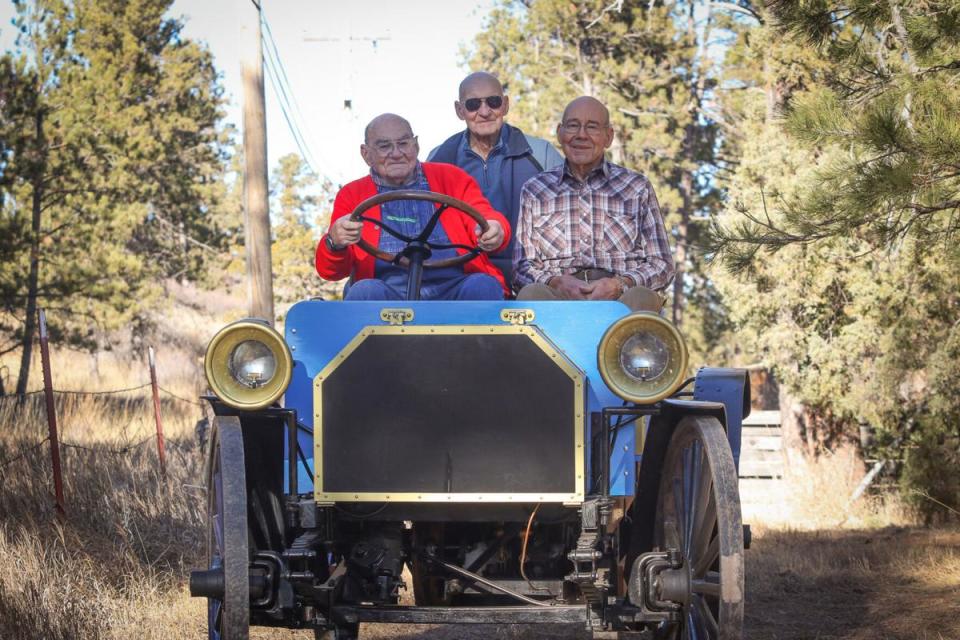
The Auto Buggy was discontinued in 1912 as the company focused on trucks, but the Auto Wagon remained in production until 1917.
More than a century later, in 2019, Bob Grimm and his brothers Dave Grimm and Don Grimm started the four-year process of building their auto buggy.
Building and repairing vehicles together is a lifelong hobby and vocation for Bob, Don and Dave Grimm. They grew up on a farm in New Underwood where Bob said the brothers learned a lot by repairing their own equipment.
Later, Bob and Don were business partners for 27 years at Grimm’s Pump Service, and Dave worked there for several years.
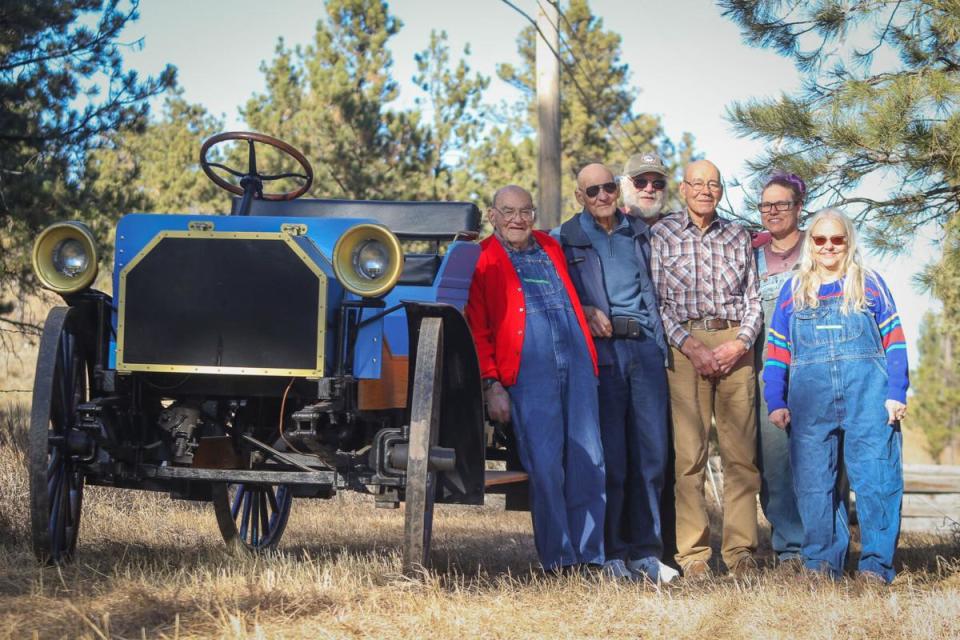
This project started with an original frame from an International Harvester auto buggy that was among a collection of parts stashed in Bob Grimm’s shed.
“We bought a bunch of antiques from this man who was a collector in Nebraska, so he wanted to know if I wanted to take that buggy,” Bob said.
“I’ve been collecting vehicles for about 30 years,” Bob said. “I bought engines that were not working and then repaired them until they were operational again. That was what I did for my hobby…I had accumulated a lot of miscellaneous things and headlights (that I) just had stored in my shed.”
The brothers worked from a drawing of the auto buggy and built it using an amalgamation of foraged and custom-built parts. The finished auto buggy came together thanks to the talents and mechanical know-how of three generations of the Grimm family.
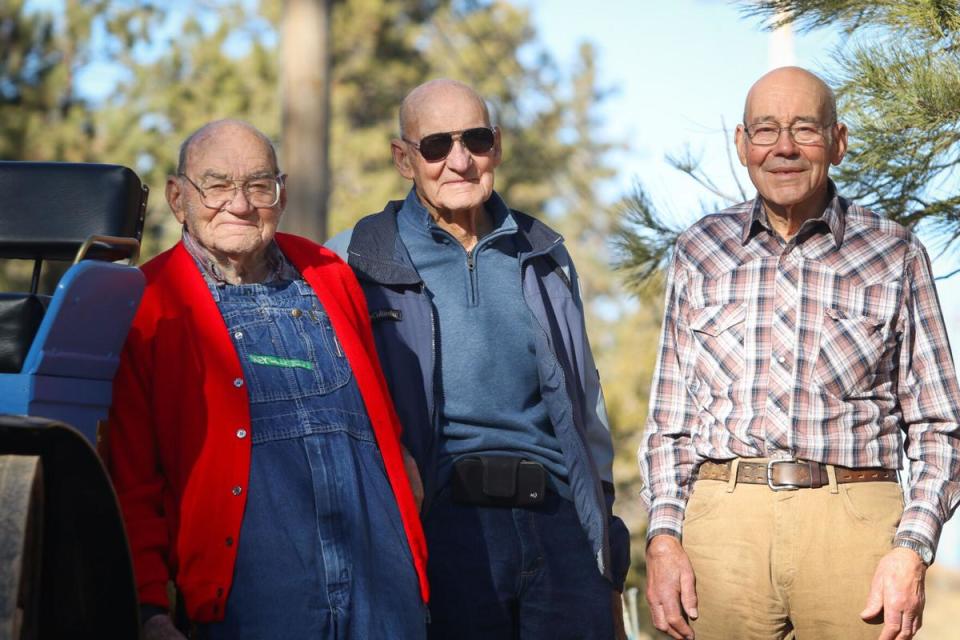
The auto buggy’s engine, from Bob’s collection, was an old two-cylinder, four-cycle engine that originally came from a hand car used by section crews on a railroad, Don said. The brothers also had flat wheels — similar to wagon wheels — that Rhino Lining Company in Rapid City resurfaced by spraying them with a ¾-inch layer of rubber to give them some cushion.
Bob, assisted by his daughter, Connie Hilpert, initially did much of the work on the buggy. The project reached a point where “it was done but couldn’t be finished,” Don said. He, Dave, Connie’s husband, Fred, and Bob’s granddaughters, Kirston and Lori Hilpert, joined the project to finish the auto buggy.
“After the engine was mounted, the wood frame replaced and the hood was all made and the lights was on and all that was done…Bob could not do it anymore and Connie couldn’t do it alone,” Don said.
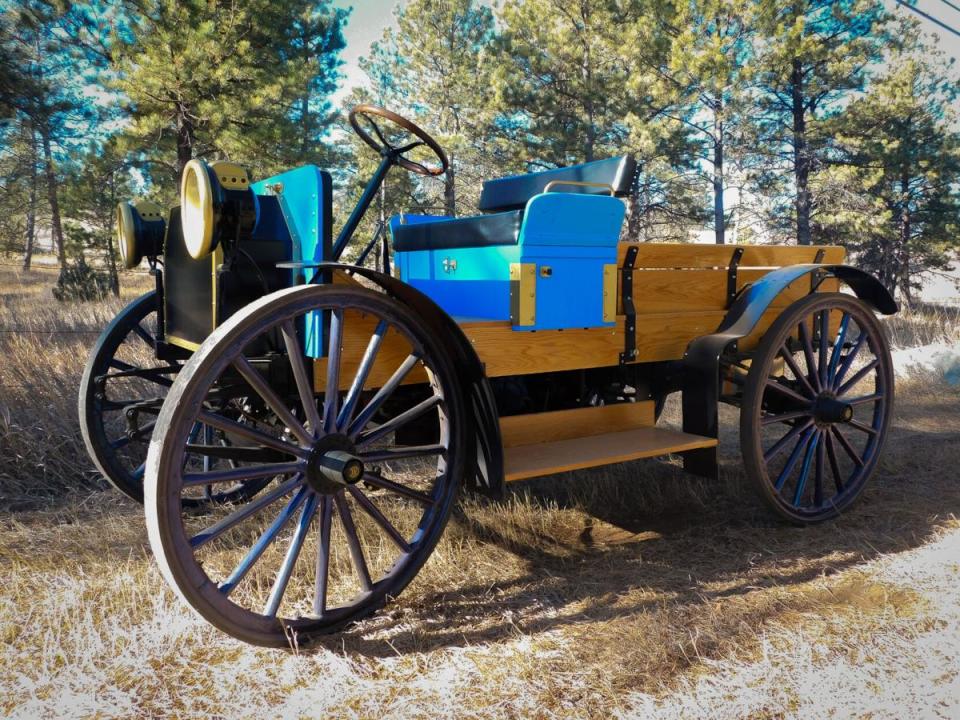
Dave and Don built fenders for the auto buggy. Don, who took up woodworking when he moved to Westhills Village in Rapid City 10 years ago, built the box and the floorboards that sit on the frame, and the sideboard. He completed all the woodwork for the auto buggy in Westhills Village’s wood shop.
“Dad and I worked on the front of the car and (the rest of the family) did all the hydraulics. They did the braking system, the steering system. They did a lot of things that make it go,” Connie said.
Connie’s husband, Fred, is a civil engineer who describes himself as “the finder of stuff” needed to construct the auto buggy. Because of the many people Bob, Dave and Don know in the community, Fred said the brothers were often able to direct him to someone or some place where Fred could find the parts needed for the auto buggy.
“We had a lot of help from different people and businesses around the community that did a little of this and a little of that,” Connie said, including Dakota Fluid Power, Pacific Steel, Menard’s, NAPA Auto Parts and Ace Hardware.
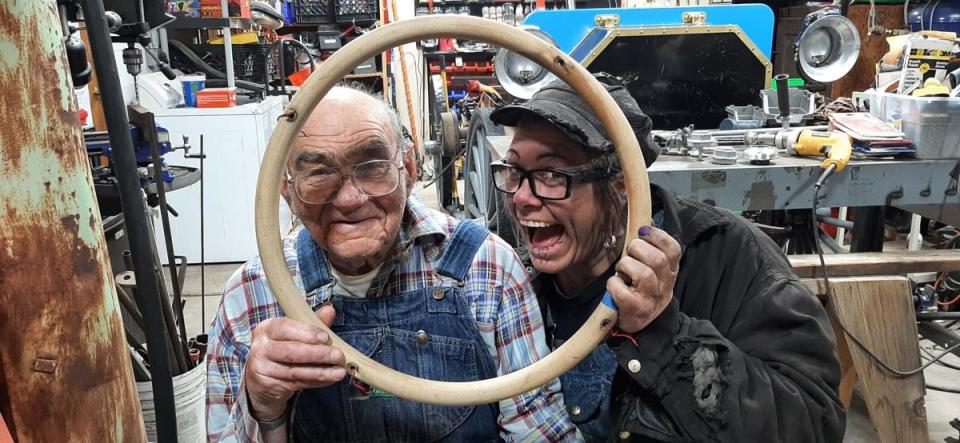
One piece of equipment that couldn’t be found was a transmission of the era, so the family devised a hydraulic system that propels the vehicle forward and backward. Don estimates the auto buggy travels at a speed of about four miles an hour, “just a real fast walk.”
“I looked really hard to try to find a transmission for a 1907 auto buggy and couldn’t find a transmission,” Fred said. “The problem was getting horsepower from the engine to the wheels and so we came up with a hydraulic design.”
Blacksmith, welder add their skills
Connie and Fred’s daughters, Kirston and Lori Hilpert, brought blacksmithing and welding skills to the project. Kirston works for the 1880 Train in Hill City and is one of only eight female steam locomotive engineers in the United States. Lori has been a professional welder for seven years and she works in the machine shop at All Metal Manufacturing in Rapid City. The two sisters have built and own their own forge.
Connie said Bob, Dave and Don have welding and blacksmithing skills, but they turned those projects over to Kirston and Lori. Lori welded a custom tank to hold hydraulic fluid.
“We don’t have an actual transmission in the auto buggy because we couldn’t find one, so Dad (Fred) came up with the idea to do it with hydraulics. It’s got the antique motor in it and instead of running a transmission, it uses a flywheel to turn a hydraulic pump,” Lori said. “Hydraulics require fluid and that required building a tank to run the pump.”
“A lot of things we needed designed and welded, Lori did those,” Connie said. “Kirston and Lori used their foundry skills to cast one of the hubcaps that was missing, and she took axels apart and remanufactured springs.”
“We took apart the (auto buggy) frame and re-riveted it and refabricated it,” Lori said.
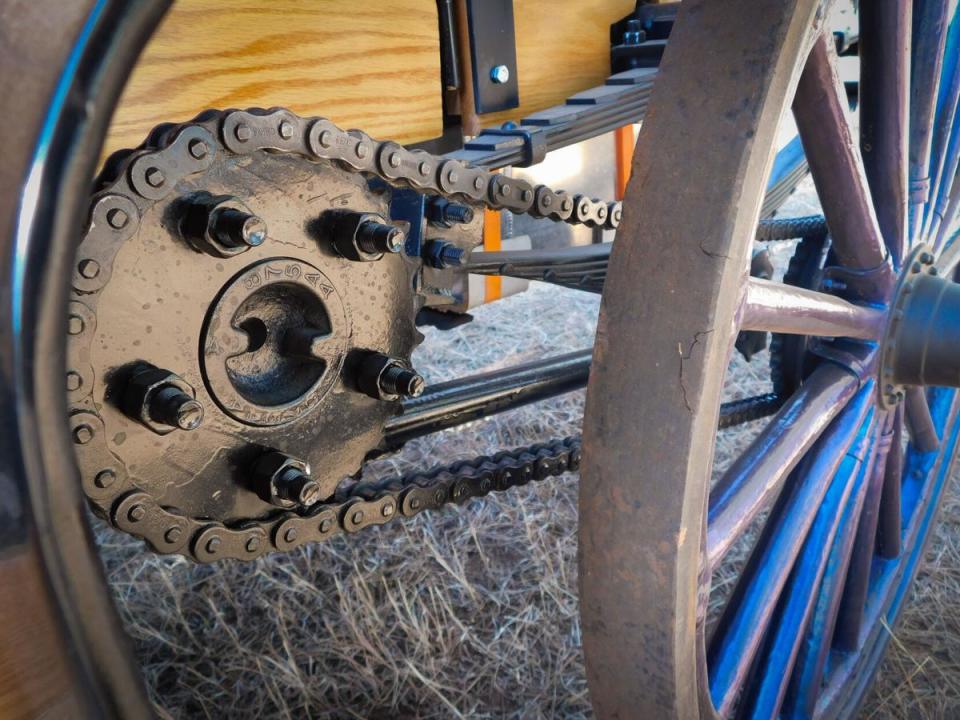
“We all brought some specific skills to it that were needed, like pouring the hubcab out of aluminum. That was something I knew how to do from working on the train,” Kirston said.
For Kirston and Lori, part of the joy of the project was using the skills and talents their family nurtured and encouraged. Both say they wished they’d had more time to work with Dave and Don on the auto buggy project.
“Lori and I both got the inspiration to do the things we do in life from our grandparents,” Kirston said. “My Grandpa has shown me blacksmithing, and working on the train was inspired by Grandpa letting us mess around with steam tractors…(Bob Grimm and his son Mike) never shied away from letting any of the cousins that wanted to participate in thrashing wheat. They never hesitated to let any of us do that. I don’t think that’s an opportunity many young women have been afforded — to work with antique equipment.”
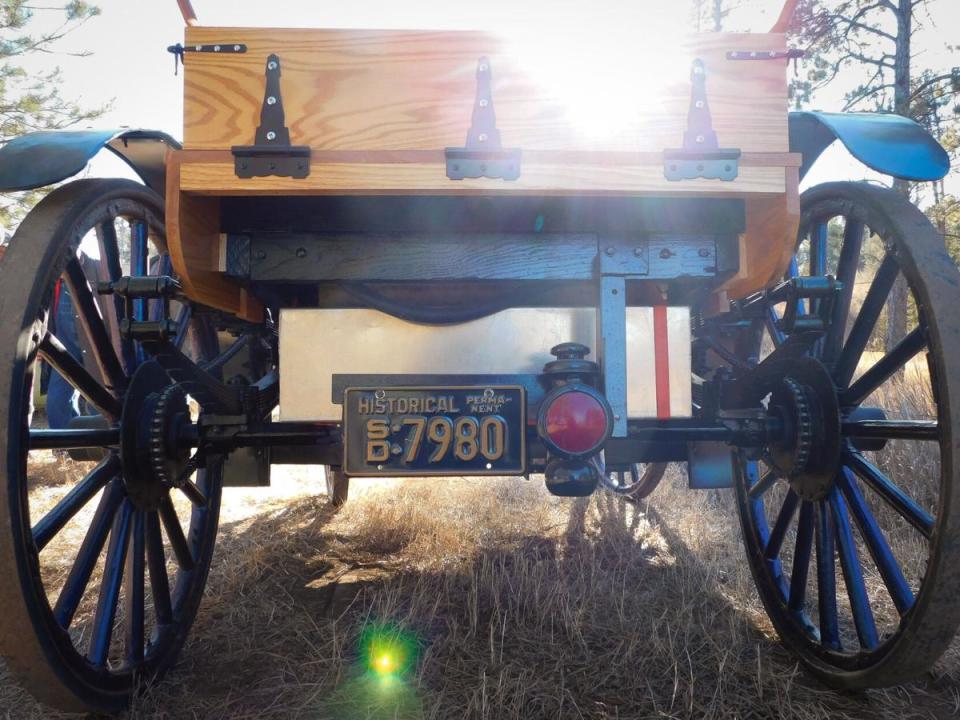
Lori was introduced to welding by Fred’s mother, and welding had been Lori’s hobby since college until finally she decided to make it her career.
“(Our grandparents) were always good about explaining stuff and teaching us and passing on that knowledge. It was an education, and all of our grandparents were good about encouraging and teaching us and not brushing us off,” Lori said. “We would go out and play with stuff on (Bob Grimm’s) farm. By that time, our grandfather would go out there and mess around with all of his projects and we were allowed to participate in that.”
While the sisters were living in Phoenix, Ariz., Lori took classes to learn welding. Inspired by her sister, Kirston took the only blacksmithing class in Phoenix, loved it and took it so many times that she became the teacher’s assistant before eventually finding a career at the 1880 Train that incorporated blacksmithing.
Spending time together is an aspect of this project all the family members cherished. The three Grimm brothers laughed as they agreed one thing they liked most was going to lunch together.
“We worked one day a week (on the auto buggy),” Don said. “It was a fun project. It was fun figuring out how to make it work.”
“I looked forward to it,” Dave said, chuckling. “We never got in any fights, I guess.”
The entire family is thrilled with the completed auto buggy.
“It’s way beyond what I expected,” Bob said. “I never had any idea we could come up with something as good as it turned out.”
The only thing still missing from the vehicle is the International Harvester symbol that will be affixed to the front. The family is still trying to figure out how to create it. Connie said they might try computer-aided drafting or perhaps 3D printing — technology not yet dreamed of in 1907 — to make the final flourish for their auto buggy.
This article originally appeared on Sioux Falls Argus Leader: Three brothers and an auto buggy: Building 1907 vehicle from scratch a family project

